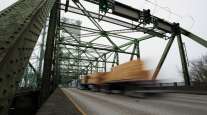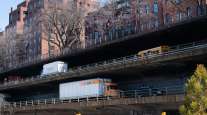Trump ‘Self-Help’ Infrastructure Plan Irks State, Local Leaders

Mayors and state lawmakers from both parties are blasting President Donald Trump’s proposed transportation budget and $1 trillion infrastructure initiative, saying his plans would cut federal funding for critical projects and leave them holding the bill.
The backlash comes after Trump last week revealed a plan for upgrading roads, bridges, airports, sea ports and other public works that relies heavily on what his administration called “self-help.” Under the plan, new federal spending would be used primarily as an incentive for states, cities and private investors to come up with most of the money.
At the same time, Trump proposed cutting $1.4 billion next year from transportation and transit grant programs and included no new federal spending from a highway trust fund.
“Most cities, when they’ve been listening to the dollars that the White House wants to spend on transportation, they’ve been expecting that there’d be a significant influx of dollars coming out of Washington to help address the needs that we have,” said Oklahoma City Mayor Mick Cornett, a Republican and president of the U.S. Conference of Mayors. “It’s continually disappointing that we have to put these efforts together to try and restore what we think is an investment in cities and the country.”
The Trump administration is trying to avoid dictating to state and local officials how to spend federal infrastructure dollars, and “returning the power to those authorities,” White House spokeswoman Natalie Strom said.
“That will allow us to invest an additional $200 billion of federal money to directly support the projects that truly require federal assistance and incentivize the most investment both from state and local governments and the private sector,” she said.
‘Overtaxed Today’
State and local leaders generally agree that they should put up some of their own money to qualify for federal help. In fact, almost half of all states have raised gas taxes in the last four years, and cities and states have issued debt or passed ballot measures to fund infrastructure spending. State budgets are already stretched and could be headed for even greater pressure with proposed cuts to Medicaid and other federal programs looming.
“Our citizens think they’re overtaxed today,” Cornett said. “If the idea is that we’re going to somehow pass initiatives with funding to keep up the roads and the bridges and all of the infrastructure that’s out there, that seems like a tough sell to me.’’
Scott Pattison, executive director of the National Governors Association, said states and localities won’t be able to finance infrastructure needs without more federal funding. “They will continue to try to do what they can, but they’re not the national government with the same access to resources,” he said.
Federal funds for infrastructure are generally allocated through competitive grants and loans, as well as by formulas that reimburse states and localities for a certain share of a project’s eligible costs. The Highway Trust Fund, for example, which is mainly funded by federal gas and diesel taxes, granted $22.3 billion for surface transportation from October through April and $4.6 billion for transit work, according to the Federal Highway Administration.
‘Huge Challenge’
Sarah Kline, a fellow with the Bipartisan Policy Center, a Washington-based research group focused on infrastructure, said state and local governments couldn’t simply replace federal support, especially when it comes to major upfront capital expenditures at the beginning of a project.
“The notion that if the federal government kind of backs out, that states and localities are going to be just jumping in to completely fill that hole, that would be a huge challenge for them,’’ Kline said.
Trump campaigned on a pledge to invest $1 trillion to upgrade the nation’s infrastructure. His budget and the outline of his infrastructure plan, released May 23, call for most of that money to come from states, localities and private-sector entities: Trump’s plan would allocate $200 billion in federal funding over the next decade, primarily to spur at least $800 billion of investment. The administration has said it plans to have a legislative package ready by the third quarter.
‘Model of Independence’
U.S. Transportation Secretary Elaine Chao said last week that the federal government will do its “fair share,” but that it doesn’t want to create a disincentive for states and localities to do more. The White House said in a fact sheet for the plan that the federal government “should support more communities moving toward a model of independence.”
Trump’s budget proposal also called for cutting $928 million from a federal grant program for transit projects and $499 million from another that funds road, rail, transit and port projects that have significant regional or national impact. It would also reduce spending from the federal Highway Trust Fund after 2020 to match declining revenues.
The transportation cuts and others in such programs as Community Development Block Grants, would be “devastating” and could bankrupt small cities, said Matt Zone, president of the National League of Cities and a Cleveland councilman.
Los Angeles Mayor Eric Garcetti, a Democrat who’s chairman of the U.S. Conference of Mayors’ infrastructure task force, said the transportation budget proposal “would leave communities from small towns to large cities fending for themselves.”
Tight Budgets
“At a time when Americans need Washington to accelerate investment in our future, the administration is throwing the gear into reverse,” said Garcetti, who backed a successful ballot measure to raise the Los Angeles sales tax last year to generate more than $120 billion for transportation projects over 40 years.
Six states this year raised their gas taxes — joining 18 others that have raised or changed the tax since 2013 to generate more money for transportation work, according to the Institute on Taxation and Economic Policy. The federal gas tax hasn’t been increased since 1993.
“The devil’s going to be in the details, but so far, I don’t see how the numbers add up,” said Indiana Representative Ed Soliday, a Republican who helped lead the effort to increase the state gas tax this year and is co-chairman of a public-private partnership project for the National Conference of State Legislators. “Sooner or later, somebody has to pay.”
John Hicks, executive director of the National Association of State Budget Officers, said it isn’t clear whether states and localities will have the capacity to take on significant additional debt and spending for infrastructure. Two-thirds of U.S. states have reduced revenue estimates this year, and about half are still spending less than they were before the recession, adjusted for inflation, he said.
State budgets could be hit hard if Trump’s budget and the health-insurance bill passed by the House on May 4 go into force, Hicks said. Those plans would cut Medicaid — the joint federal-state health-care program for the poor — by about $1.7 trillion through 2026.
Much more direct federal spending is needed to meet long-term infrastructure needs and to get Democratic votes for a bill in Congress, said Ed Rendell, the former Democratic governor of Pennsylvania who co-founded Building America’s Future, a bipartisan coalition of officials that promotes infrastructure spending.
“We can’t do it on the cheap,” said Rendell, a former Philadelphia mayor. “Washington wants to push the responsibility for funding everything that the nation needs to somebody else.”




